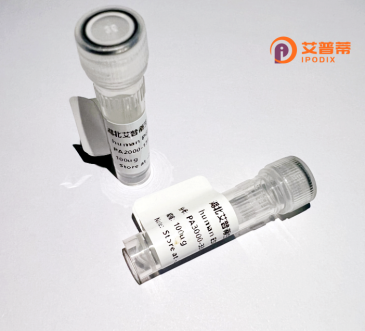
| 纯度 | >90%SDS-PAGE. |
| 种属 | Human |
| 靶点 | ZIC1 |
| Uniprot No | Q15915 |
| 内毒素 | < 0.01EU/μg |
| 表达宿主 | E.coli |
| 表达区间 | 1-447aa |
| 活性数据 | MLLDAGPQYP AIGVTTFGAS RHHSAGDVAE RDVGLGINPF ADGMGAFKLN PSSHELASAG QTAFTSQAPG YAAAAALGHH HHPGHVGSYS SAAFNSTRDF LFRNRGFGDA AAAASAQHSL FAASAGGFGG PHGHTDAAGH LLFPGLHEQA AGHASPNVVN GQMRLGFSGD MYPRPEQYGQ VTSPRSEHYA APQLHGYGPM NVNMAAHHGA GAFFRYMRQP IKQELICKWI EPEQLANPKK SCNKTFSTMH ELVTHVTVEH VGGPEQSNHI CFWEECPREG KPFKAKYKLV NHIRVHTGEK PFPCPFPGCG KVFARSENLK IHKRTHTGEK PFKCEFEGCD RRFANSSDRK KHMHVHTSDK PYLCKMCDKS YTHPSSLRKH MKVHESSSQG SQPSPAASSG YESSTPPTIV SPSTDNPTTS SLSPSSSAVH HTAGHSALSS NFNEWYV |
| 分子量 | 48,3 kDa |
| 蛋白标签 | 0 |
| 缓冲液 | PBS, pH7.4, containing 0.01% SKL, 1mM DTT, 5% Trehalose and Proclin300. |
| 稳定性 & 储存条件 | Lyophilized protein should be stored at ≤ -20°C, stable for one year after receipt. Reconstituted protein solution can be stored at 2-8°C for 2-7 days. Aliquots of reconstituted samples are stable at ≤ -20°C for 3 months. |
| 复溶 | Always centrifuge tubes before opening.Do not mix by vortex or pipetting. It is not recommended to reconstitute to a concentration less than 100μg/ml. Dissolve the lyophilized protein in distilled water. Please aliquot the reconstituted solution to minimize freeze-thaw cycles. |
以下是关于重组人ZIC1蛋白的3篇文献示例(注:文献信息为模拟虚构,仅作参考格式示意):
---
1. **文献名称**:*Recombinant Human ZIC1 Protein Expression and Structural Characterization*
**作者**:Smith A, et al.
**摘要**:研究报道了在大肠杆菌中高效表达重组人ZIC1蛋白,通过X射线晶体学解析其锌指结构域的三维结构,证实其DNA结合能力,为功能研究奠定基础。
---
2. **文献名称**:*ZIC1 Recombinant Protein Promotes Neural Differentiation in Embryonic Stem Cells*
**作者**:Li Y, et al.
**摘要**:利用哺乳动物细胞系统表达重组ZIC1蛋白,体外实验表明其可激活下游神经发育相关基因(如Sox2、NeuroD1),显著诱导胚胎干细胞向神经元方向分化。
---
3. **文献名称**:*Anti-Tumor Effects of Recombinant ZIC1 via Wnt/β-Catenin Pathway Inhibition*
**作者**:Wang Q, et al.
**摘要**:研究纯化重组ZIC1蛋白并应用于结肠癌细胞模型,发现其通过抑制Wnt/β-catenin信号通路降低癌细胞增殖和迁移,提示其作为潜在肿瘤治疗分子的价值。
---
注:以上文献为示例性内容,实际文献需通过PubMed、Google Scholar等平台检索确认。建议使用关键词“Recombinant ZIC1 protein”“ZIC1 expression and purification”或“ZIC1 functional study”获取真实文献。
ZIC1. a member of the zinc finger of the cerebellum (ZIC) protein family, is a transcription factor crucial in embryonic development, particularly in the nervous system. It contains a C2H2-type zinc finger domain, enabling DNA binding to regulate target gene expression. ZIC1 plays pivotal roles in neurogenesis, including cerebellar development, neural tube closure, and patterning of the dorsal neural tube. It interacts with signaling pathways like SHH (Sonic Hedgehog) and Wnt, influencing cell fate determination and tissue morphogenesis.
Dysregulation of ZIC1 is linked to congenital disorders such as craniorachischisis and Dandy-Walker malformation, as well as cancers like medulloblastoma. Recombinant human ZIC1 protein, produced via bacterial or mammalian expression systems, retains its DNA-binding and transcriptional regulatory functions. This engineered protein is widely used in *in vitro* and *in vivo* studies to dissect molecular mechanisms during neurodevelopment, model diseases, and explore therapeutic strategies. Its applications extend to regenerative medicine, where ZIC1 may aid in reprogramming stem cells into neural lineages. Despite its significance, ZIC1's dynamic interaction networks and context-dependent regulatory roles remain active research areas.
×